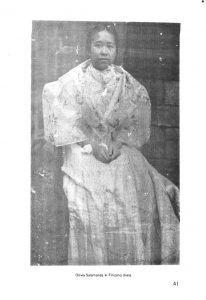 About the author: Olivia Salamanca, M.D. (July 1, 1889 — July 11, 1913). Her life was summarized by Dr. Encarnacion Alzona, Ph.D., in a paper presented to the National Academy of Science and Technology as follows:
About the author: Olivia Salamanca, M.D. (July 1, 1889 — July 11, 1913). Her life was summarized by Dr. Encarnacion Alzona, Ph.D., in a paper presented to the National Academy of Science and Technology as follows:
Olivia Salamanca was one of the 37 Filipino students who were appointed scholars by the Philippine Government to study in the United States in 1905. There were two other girls beside her. There should have been four of them, but the fourth, who obtained the highest rating in the examination, turned out to be only 12 years old, and 16 was the minimum age required by law. Her name was Felisberta Asturias. The feminists at that time must have rejoiced over her memorable feat..
Luckily the parents of Olivia Salamanca, unlike many Filipino parents at that time, were willing to permit their daughter to study in that faraway country, then little known to the Filipinos.
Arriving in the United States in 1905, she was sent to St. Paul, Minn. to finish the secondary course. Then, she went to Philadelphia to enroll in the Women’s Medical College there, the medical course being her personal choice. Her academic record at the medical college was admirable. In her second year she won a prize in anatomy and physiology. She graduated on 1 June 1910 with an average of “A”. She was then 20 years and 11 months old. She also took the civil service examination in March 1910 and passed it easily. She was one of the editors of The Filipino, the organ of the Filipino students in America.She visited Ithaca, New York; Lakehurst, New Jersey; Washington, D.C.; Baltimore, Md.; New York City; Providence, R.I.; Prudence Island; and Boston.Then she returned to the Philippines, arriving at Manila on 24 July 1910…
…The Caviteños had a right to be proud of her: the first Caviteña, to the best of my knowledge, to obtain the degree of doctor of medicine and the second Filipino woman to hold that high distinction.
Since childhood Olivia had demonstrated exceptional intel lectual qualities. Her own father, Jose Salamanca, a cultured man, founder of a private school in San Roque, Cavite, Colegio Ligaya, and a pharmacist by profession, regarded her as his smartest daughter. When she was a student in the Cavite High School, she was admired for her recitation of poems in both Spanish and English. Also she demonstrated exceptional histrionic talent when she took part in dramatic performances. Without any guidance from a teacher, she learned to play the piano…
She was one of the charter members and the first secretary of the Philippine Antituberculosis Society which was founded on 29 July 1910. Towards the end of the same year she was found to be suffering from tuberculosis.
About the diary: The Philippine Diary Project includes the extracts from the diary included by Encarnacion Alzona in her paper. In it she mentioned that some of the entries came from a typewritten copy, incomplete and damaged: “Her diary for 1910 and 1913 in my possession is incomplete.” The article does not mention how or where she came across the diary, or any other details about it. It is to be hoped that at some future date Dr. Alzona’s heirs might be contacted so an inquiry can be made. The full paper of Dr. Alzona is available on line.